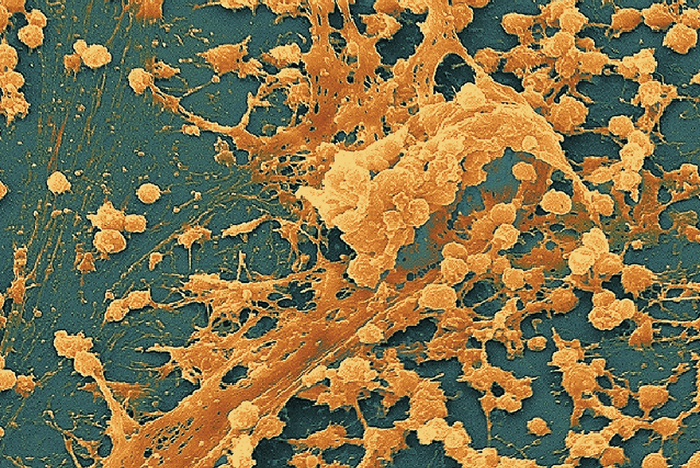

What is a biofilm? Microorganisms can be found everywhere and are typically associated with dirt and diseases. However, all living beings rely on a dynamic and sophisticated microbial ecology to perform vital functions.
In fact, the average adult has around 1kg of bacteria in their gut – similar to the weight of our brains!¹
To create a more favourable environment, microbes can form multicellular ‘communities’ on almost any surface; particularly when there is some form of moisture.
The combination of organisms and water molecules allows the cells to produce extracellular compounds that facilitate the attachment to a surface via the formation of a slimy coating.

The organisms, the slime they produce and the water molecules trapped between the slime particles are what make up a biofilm.²
The initial stage of attachment happens when the microbes generate an oozy substance called an extracellular polymeric substance (EPS).
Scientists have identified that DNA, proteins, and sugar molecules make up the majority of biofilms, enabling the microorganisms in a biofilm to stick together.³
Biofilms can be found in a whole host of settings such as the familiar slippery coating on the surfaces of rocks.
Less noticeable are biofilms on our skin and in our gut lining. One common example of a biofilm is dental plaque; a slimy build-up of bacteria that forms on the surfaces of teeth. Biofilms may also grow on implanted medical devices such as catheters and pacemakers.

These slimy coatings can act as a protective barrier as they are typically more resilient to stress and can shield away harmful germs or toxins.
Unfortunately, this defence can be compromised when the ratio of good and bad bugs is out of balance.
Biofilms, both bacterial and fungal, have been implicated in a variety of health conditions. In 2002, the National Institutes of Health (NIH) announced that biofilms accounted “for over 80% of microbial infections in the body.”
As biofilms can grow on implanted medical devices such as prosthetic heart valves, joint prosthetics, catheters and pacemakers, this can lead to multiple infections. These infections can cause serious health problems such as endocarditis, pneumonia and most worryingly, an army of anti-biotic resistant bacteria, protected in their biofilm habitat.
“A biofilm can be up to 1500 times more resistant to antibiotics and other biological and chemical agents.”
1 = Collective unconscious: How gut microbes shape human behavior. Dinan, T. 2015
2 = Biofilm Formation: A Clinically Relevant Microbiological Process. Donlan, R. 2001
3 = Biofilms. Lopez, D. 2010
4 = Not just slime: Beneath the slippery exterior of a microbial bio film lies a remarkably organized community of organisms. Elia, T. 1999






Accepting payments via


YourHealthBasket © 2025
detoxpeople Ltd
Registered in England & Wales 07156741
VAT reg GB 103 3641 60
Our new practitioner portal has been released and it’s now easier than ever to link a client’s account and provide them with suggestions using our new protocol system.
Convert your current cart into a protocol which can then be assigned to a linked client.